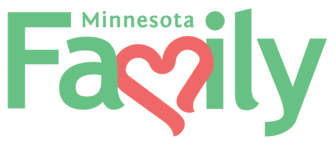We all remember the moment when we first held our newborn in our arms and dreamed of all the wonderful adventures that lie ahead. We dreamed of their first smile, their first steps, and their first words.
But what happens when those first words don’t come as early or as easily as we thought? Sometimes, to no fault of your own or your child’s, a little one’s speech and language development can be delayed or even disordered.
With an eye to our fabulous state of Minnesota, here are 10 simple ways to intentionally support speech and language development in your child.
1. Use lots of engaging facial expressions, as this keeps your little one engaged in watching your face and pulls them into what you are doing. They think it is a game and who doesn’t love a good game? For example, think exaggerated, oohs and ahhs, and smiles and surprised faces. Make eye contact with your little one, make a face, make a fun noise, and watch their reaction. They are figuring you out!
2. Make singing a part of your day as the rhythm in sing-song tones is so important! Did you know that speech and language have their own prosody or song patterns? When we ask a question, our voice goes up at the end and when we make our statement, our voice goes down at the end. This is the song of speech. Minnesotans have their own speech song “Don’t ya know?” So make up little ditties and introduce them to the rhythm of your speech. Your little one won’t remember all that you sang to them but they will remember the joys of singing.
3. Be a chatterbox and talk to your child all day long. Explain to them what you are doing in short, simple sentences. For example, “I’m taking your socks off! 1-2-3-4-5 toes!” or even something as simple as “Good morning! I’m getting you out of bed and hugging you tight.” Tell them what you are doing and use your words!
4. Use gestures as well as this holds your child’s attention span longer and adds to the communication cues you’re giving them. We already do this when we wave hello, and goodbye. Just expand this to very simple baby signs that add a visual cue to your communication. Consider adding simple baby signs such as “more” and “all done” as research shows us little ones are able to use sign language before they are able to speak. Snow falling is one of my favorite signs and then I lightly land my fingers on the little one’s face as pretend snowflakes.
5. Make those animal sounds and yes that means mooing like a cow and baaing like a sheep. Animal sounds are mainly vowels with very visual initial consonants. These are some of the first sounds that your little one will imitate.
6. Read read read. Books are perfect for supporting both listening and talking skills and increasing the attention span and focus of your little ones as well. Minnesota has four distinct seasons so consider taking trips to the library and choosing season books and then stepping outside into our wonderful Minnesota outdoors and looking at, feeling, and talking about what you read.
7. Pause…remember to say something to your child and then…just…wait…Wait for your child to make any intentional response and celebrate that communication exchange. The pause provides powerful processing time.
8. Provide opportunities for your child to communicate. Ask them a question and then wait for their reply. Your questions should start off as very simple such as yes/no questions such as, “Are you hungry?” and then advance into two-choice questions such as, “Do you want milk or juice?” Remember to pause and wait for your child to collect their answer and respond.
9. Repeat. Repeat repeat. Kids need lots of repetition to learn so repeat often and give them lots of opportunities for learning.
Here’s how it looks: During your child’s next meal, name the food they’re eating at least three times like this
Here’s how it looks: During your child’s next meal, name the food they’re eating at least three times like this
1. Offer a choice (apple and banana slices) and name their choice. Your child reaches for the apple slice so you say, “Apple.” Your voice goes down at the end as you are naming the item.
2. Name it again, once they’ve picked what they have wanted and this time, have your voice go up at the end like you are asking a question. “Apple?”
3. Name it again as you give your child their choice with your voice going down and confirming the word. “Apple.”
10. Enjoy this time with your child and follow your child’s lead. Your child is going to be naturally curious and will learn best when they are engaging with things that are interesting to them. Find out what they are curious about. Touch it, feel it, look at it, taste it and most of all, talk about it.
So explore their world and Minnesota with them and use words along the way. Take the time to introduce your child to the beautiful things that our world, and especially our beautiful state have to offer, and step into these 10 simple ways to support speech and language development in your child. You got this!

